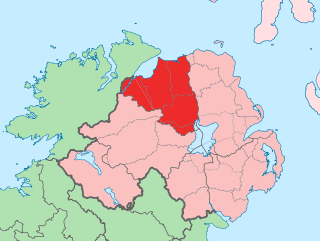
County Londonderry, also known as County Derry, is one of the six counties of Northern Ireland, one of the thirty two counties of Ireland and one of the nine counties of Ulster. Before the partition of Ireland, it was one of the counties of the Kingdom of Ireland from 1613 onward and then of the United Kingdom after the Acts of Union 1800. Adjoining the north-west shore of Lough Neagh, the county covers an area of 2,118 km2 (818 sq mi) and today has a population of about 247,132.

Limavady is a market town in County Londonderry, Northern Ireland, with Binevenagh as a backdrop. Lying 17 miles (27 km) east of Derry and 14 miles (23 km) southwest of Coleraine, Limavady had a population of 12,032 people at the 2011 Census. In the 40 years between 1971 and 2011, Limavady's population nearly doubled. Limavady is within Causeway Coast and Glens Borough.

Coleraine is a town and civil parish near the mouth of the River Bann in County Londonderry, Northern Ireland. It is 55 miles (89 km) northwest of Belfast and 30 miles (48 km) east of Derry, both of which are linked by major roads and railway connections. It is part of Causeway Coast and Glens district.

Ballymoney is a town and civil parish in County Antrim, Northern Ireland. It is within the Causeway Coast and Glens Borough Council area. The civil parish of Ballymoney is situated in the historic baronies of Dunluce Upper and Kilconway in County Antrim, as well as the barony of North East Liberties of Coleraine in County Londonderry. It had a population of 10,402 people at the 2011 Census.
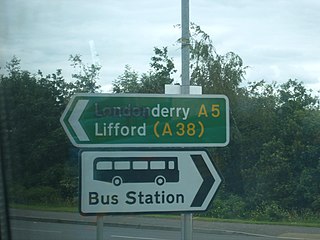
The names of the city and county of Derry or Londonderry in Northern Ireland are the subject of a naming dispute between Irish nationalists and unionists. Generally, although not always, nationalists favour using the name Derry, and unionists Londonderry. Legally, the city and county are called "Londonderry", while the local government district containing the city is called "Derry City and Strabane". The naming debate became particularly politicised at the outset of the Troubles, with the mention of either name acting as a shibboleth used to associate the speaker with one of Northern Ireland's two main communities. The district of Derry and Strabane was created in 2015, subsuming a district created in 1973 with the name "Londonderry", which changed to "Derry" in 1984.
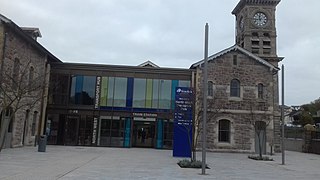
Derry/Londonderry railway station, known commonly as Waterside railway station, is a railway terminus in Derry, Northern Ireland, on the east bank of the River Foyle, operated by Northern Ireland Railways. It is on the Belfast–Derry railway line, terminating at Belfast Great Victoria Street.

The Belfast–Derry line runs from Belfast to Derry in Northern Ireland. The line is double-track on the short section it shares with the Belfast–Larne line, but is composed primarily of single track from Monkstown to Derry with passing points at Templepatrick, Antrim, Magherabeg, Ballymena, Killagan, Ballymoney, Coleraine and Bellarena.

Northern Ireland is divided into six counties, namely: Antrim, Armagh, Down, Fermanagh, Londonderry and Tyrone. Six largely rural administrative counties based on these were among the eight primary local government areas of Northern Ireland from its 1921 creation until 1973. The other two local government areas were the urban county boroughs of Derry and Belfast.
The North West Senior Cup or North West Cup is a senior football competition in Northern Ireland run by the North West of Ireland Football Association. Senior and intermediate teams from the North West FA's jurisdiction, are entitled to enter. It originated as the County Londonderry F.A. Cup in 1886–87 but became the North West Cup in 1892.
The Driver and Vehicle Agency is a government agency of the Department for Infrastructure in Northern Ireland. The agency is responsible for conducting vehicle testing, driver testing and the issuance of driving licences.
Vehicle registration plates in Northern Ireland use a modified version of the British national registration plate system that was initiated for the whole of the United Kingdom of Great Britain and Ireland in 1903. Originally, all counties in the UK were allocated two identification letters. At that time, the whole of Ireland was in the UK, and the letters I and Z were reserved for the Irish counties. The 'I' series was used first, but by the time it came to using the 'Z' series in 1926, the Irish Free State had already come into existence, and so it was agreed that the Northern Ireland would use the AZ – YZ series, while the Free State would use the ZA – ZZ series. In 1987, the Republic of Ireland broke away from the system altogether. As of 2002 there were reportedly 794,477 recorded registration plates in Northern Ireland, compared to only 50 for the island as a whole when the format was first introduced in 1903.
The High Sheriff of County Londonderry is King Charles III's judicial representative in County Londonderry. Initially an office for lifetime, assigned by the ruling monarch, the High Sheriff became annually appointed from the Provisions of Oxford in 1258. Besides his judicial importance, he has ceremonial and administrative functions and executes High Court Writs.

The Bishop Street Courthouse is a judicial facility in Bishop Street, Derry, County Londonderry, Northern Ireland. It is a Grade A listed building.

Omagh Courthouse is a judicial facility in High Street, Omagh, County Tyrone, Northern Ireland. It is a Grade B+ listed building.

The Old Courthouse is a former judicial facility on Castlerock Road in Coleraine, County Londonderry, Northern Ireland. It is a Grade B1 listed building.

County Hall is a municipal facility at Galgorm Road in Ballymena, County Antrim, Northern Ireland. It served as the headquarters of Antrim County Council from 1970 to 1973.
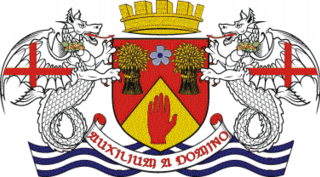
Londonderry County Council was the authority responsible for local government in County Londonderry, Northern Ireland.
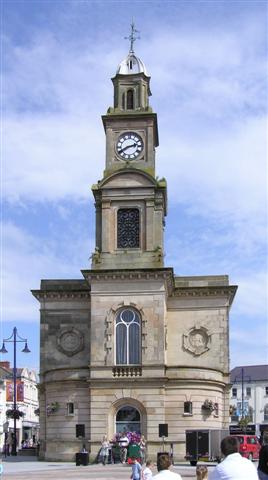
Coleraine Town Hall is a municipal structure in The Diamond in Coleraine, County Londonderry, Northern Ireland. The town hall, which was the headquarters of Coleraine Borough Council, is a Grade B1 listed building.
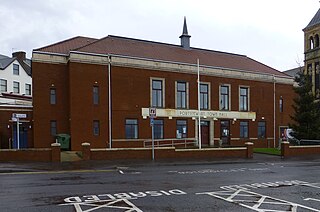
Portstewart Town Hall is a municipal structure in The Crescent, Portstewart, County Londonderry, Northern Ireland. The structure, which has been closed to the public since December 2019, is a Grade B2 listed building.
















